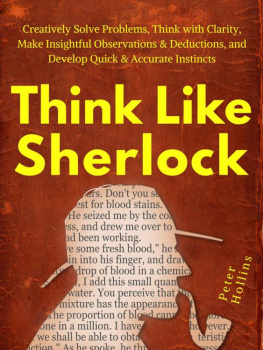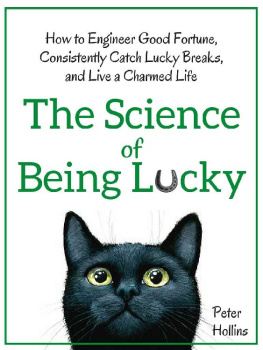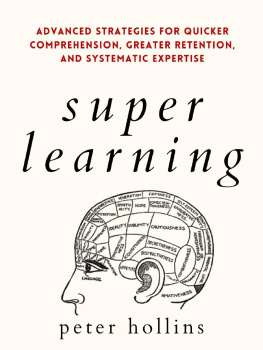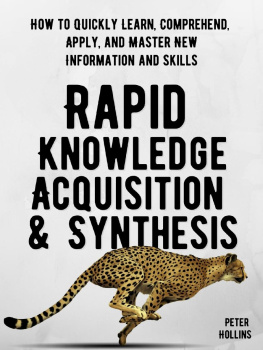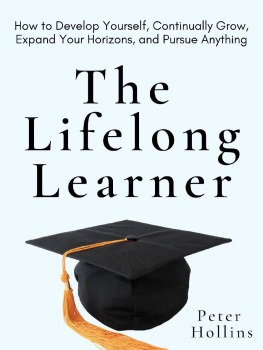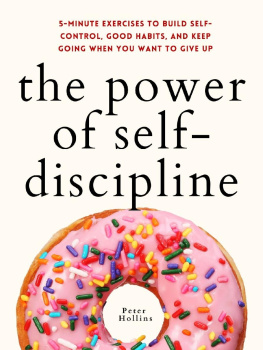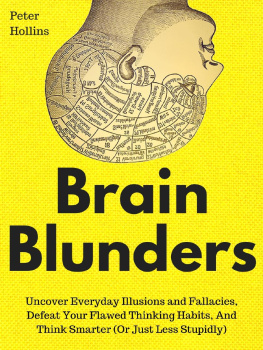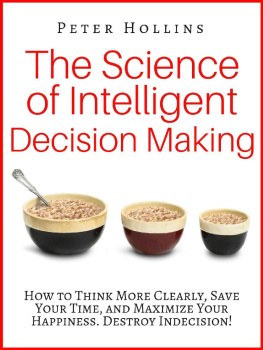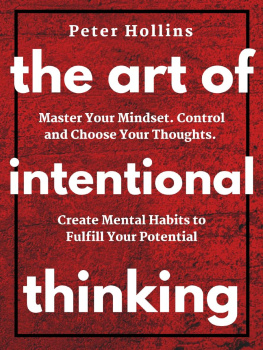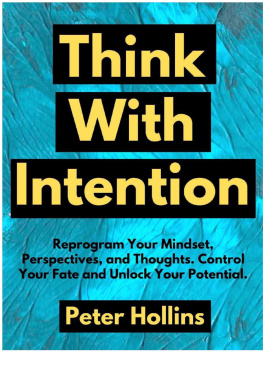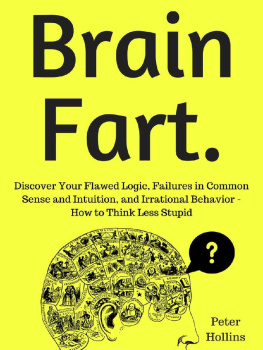Peter Hollins - Think Like Sherlock: Creatively Solve Problems, Think with Clarity, Make Insightful Observations & Deductions, and Develop Quick & Accurate Instincts
Here you can read online Peter Hollins - Think Like Sherlock: Creatively Solve Problems, Think with Clarity, Make Insightful Observations & Deductions, and Develop Quick & Accurate Instincts full text of the book (entire story) in english for free. Download pdf and epub, get meaning, cover and reviews about this ebook. genre: Romance novel. Description of the work, (preface) as well as reviews are available. Best literature library LitArk.com created for fans of good reading and offers a wide selection of genres:
Romance novel
Science fiction
Adventure
Detective
Science
History
Home and family
Prose
Art
Politics
Computer
Non-fiction
Religion
Business
Children
Humor
Choose a favorite category and find really read worthwhile books. Enjoy immersion in the world of imagination, feel the emotions of the characters or learn something new for yourself, make an fascinating discovery.
- Book:Think Like Sherlock: Creatively Solve Problems, Think with Clarity, Make Insightful Observations & Deductions, and Develop Quick & Accurate Instincts
- Author:
- Genre:
- Rating:5 / 5
- Favourites:Add to favourites
- Your mark:
- 100
- 1
- 2
- 3
- 4
- 5
Think Like Sherlock: Creatively Solve Problems, Think with Clarity, Make Insightful Observations & Deductions, and Develop Quick & Accurate Instincts: summary, description and annotation
We offer to read an annotation, description, summary or preface (depends on what the author of the book "Think Like Sherlock: Creatively Solve Problems, Think with Clarity, Make Insightful Observations & Deductions, and Develop Quick & Accurate Instincts" wrote himself). If you haven't found the necessary information about the book — write in the comments, we will try to find it.
Peter Hollins: author's other books
Who wrote Think Like Sherlock: Creatively Solve Problems, Think with Clarity, Make Insightful Observations & Deductions, and Develop Quick & Accurate Instincts? Find out the surname, the name of the author of the book and a list of all author's works by series.
Think Like Sherlock: Creatively Solve Problems, Think with Clarity, Make Insightful Observations & Deductions, and Develop Quick & Accurate Instincts — read online for free the complete book (whole text) full work
Below is the text of the book, divided by pages. System saving the place of the last page read, allows you to conveniently read the book "Think Like Sherlock: Creatively Solve Problems, Think with Clarity, Make Insightful Observations & Deductions, and Develop Quick & Accurate Instincts" online for free, without having to search again every time where you left off. Put a bookmark, and you can go to the page where you finished reading at any time.
Font size:
Interval:
Bookmark:
Creatively Solve Problems, Think with Clarity, Make Insightful Observations & Deductions, and Develop Quick & Accurate Instincts
By Peter Hollins,
Author and Researcher at petehollins.com
Click for your FREE Human Nature Cheat Sheet: 7 Surprising Psychology Studies That Will Change The Way You Think .
Think Like Sherlock Holmes
Table of Contents
There is no individual personreal or fictionalwho embodies problem-solving ability as much as Sherlock Holmes. The famous detective has gone through various interpretations, but do you know where he got his start?
Sir Arthur Conan Doyle created the British detective in 1887 in the story A Study in Scarlet . Doyle used the character of Holmes in a total of 60 adventures (four novels and 56 short stories). He was immediately popular and remains so to this day. Holmes has been portrayed in film and on television over 250 times, more than any other human literary character in history. (If not for the nonhuman Dracula, hed be the most portrayed literary character, period.) Holmes remains massively popular, even in modern updates of the character in TV series like the BBCs Sherlock and CBSs Elementary.
Why are audiences still so riveted by Sherlock Holmes? Is it the devilishly charming hat and smoking pipe he is usually portrayed with? No, its primarily because he makes solving complex problems look extraordinarily easy. Hes the superhero genius we all wish we could be.
Hes almost superhuman in how he can unravel a situation or person with what appears to be a small amount of information or data. His genius looks automatic, and his explanations of his thought processes make previously unanswerable questions look embarrassingly simple.
Holmes reveals how observation, critical thinking, and reasoning triumph in problem-solving. The amazing way he was written to be a crime-fighting force that was at once flawed and yet a genius made him relatable and made us think I can do that as well! This book aims to describe some ways you can adapt some of his techniques to solving problems in your own personal life.
Doyle created Sherlock Holmes as someone whose intelligence is off the charts and for whom problem-solving is nearly automatic. In essence, he saw connections and patterns because of his vast repository of knowledge. Thats in part because he was the epiphany of a polymathone who is an expert in a multitude of fields. Nobody can simply brush up on his methods and expect to become himits impossible. You yourself might notice if something was amiss while observing your favorite hobbyimagine having that same kind of acumen across all disciplines you come across.
But there are several ways Holmes can teach us how to improve real-life problem-solving by increasing our awareness and technique. Even if we dont possess Holmess deep intelligence, we can enhance our own skills in finding patterns and almost immediately bettering our thought processes. This book will probe how Holmes thinks, reasons, and discovers the truth and how you can adapt and shape that knack to solve your own everyday mysteries.
Who Is Sherlock Holmes and What Makes Him a Genius?
Sherlock Holmes is a private detective-for-hire in London. Because of his renown super-genius, hes often sought out by local police detectives (most famously Inspector Lestrade) to help them with cases where theyve hit a brick wall. Hes a brain mercenary, in a sense. Dr. John Watson is Holmess companion, who accompanies Holmes on most of his expeditions and tells the stories in Doyles books.
There is no case Holmes cant solve. He explains the solutions so articulately and plainly that it makes those watching him feel almost stupid for not noticing the clues in the first place. But what specifically makes Holmes such a unique genius? Lets dive into his bibliography and get acquainted with some of his most revelatory acts of creative thinking and deduction. At the end, you might notice a few common themes that we can attempt to emulate for ourselvesprobably not up to Sherlocks standard, but more than sufficient for our purposes!
Master of ciphers. Sherlock Holmes is an expert codebreaker, someone who analyzes messages written in alternative words, numbers, symbols, or patterns to keep their content secret to all those who dont know the code. Years of study and experience have enabled him to determine patterns and communication tricks criminals use to set forth their nefarious plans, and he stops them from causing more trouble than they already have.
Holmes has even written a monographa heavily detailed, written study of a single subjectin which he dissects and explains 160 entirely different ciphers. That is a lot of time spent hunkered over nonsense syllables and symbols.
In The Adventure of the Dancing Men, Holmes cracks a hieroglyphic code that uses pictures of matchstick men in various positions to send some message. He uses a method called frequency analysis, inspired by Edgar Allen Poes tale The Gold Bug. Holmes determines that each man in the hieroglyphic note represents a single alphabet character. Knowing that the most-used letter in the English alphabet is eand reasoning that Elsie, the receiver of the note, is probably addressed by name somewhere in itHolmes decodes the message in two hours and solves the case.
A younger Holmes also triumphs over cryptography in The Adventure of the Gloria Scott. After reading a seemingly meaningless letter, Holmes deduces that the real message the sender intends to say is in every third word in the texta method used in the real world by Civil War spies. In The Valley of Fear , the final Holmes novel, the detective cracks a book cipher in which the numbers in the message refer to pages and words in a published book.
This trick was used by Benedict Arnold in the Revolutionary War and Abner Doubleday in the Civil War. Of course, none of these triumphs would be possible unless you were the same freak of nature as Sherlock and happened to pen your PhD thesis on ciphers and codebreaking. How convenient for himless so for us!
Expert in footprints, forensics, and tracking. About half of all Sherlock Holmes stories contain some evidence gleaned from footprints, and Holmes was all over it. The very first Holmes story, A Study in Scarlet, describes footprints on clayey soil. The Adventure of the Lions Mane contains a long passage describing the detective following footsteps.
The Boscombe Valley Mystery takes Holmess footprint expertise to almost ridiculous lengths, using only footprint evidence to solve the case. After taking close inspection of footprints on the ground at the scene of a crime, Holmes informs Lestrade, The murderer is a tall man, left-handed, limps with the right leg, wears thick soled shooting boots, and a gray cloak, smokes Indian cigars, uses a cigar holder, and carries a blunt pen-knife in his pocket. Who didnt see that coming?
Sherlocks footprint game is extraordinary. Hes derived evidence from footprints on thousands of different surfaces: clay soil, mud, snow, carpet, ashes, and of course blood. Hes such an authority on the matter that hes written a monograph called The Tracing of Footsteps with Some Remarks on the Uses of Plaster of Paris as a Preserver of Impresses. This guy knows his audience.
Now lets just take a moment and think about how many footprints he will have needed to see in order to make those judgments. Hes more adept than a Native American Indian tracker, who has only been doing it for their entire lives. Sherlock definitely shows himself to be above the proverbial 10,000-hour rule of expertise on footprints, as he is with everything in his cases.
Expert in handwriting analysis. Back in Doyles time, handwriting analysis was highly reliable and got much more credit than it does in modern times. To that end, Holmes keeps current on graphology, the study of handwriting. He uses his mastery to make deductions that stagger the mindeven so far as to correctly identify the gender and overall character of the original writer. In The Adventure of the Reigate Squire, Holmes not only correctly guesses that a certain letter was written by two men of very different ages but that they were also related.
Font size:
Interval:
Bookmark:
Similar books «Think Like Sherlock: Creatively Solve Problems, Think with Clarity, Make Insightful Observations & Deductions, and Develop Quick & Accurate Instincts»
Look at similar books to Think Like Sherlock: Creatively Solve Problems, Think with Clarity, Make Insightful Observations & Deductions, and Develop Quick & Accurate Instincts. We have selected literature similar in name and meaning in the hope of providing readers with more options to find new, interesting, not yet read works.
Discussion, reviews of the book Think Like Sherlock: Creatively Solve Problems, Think with Clarity, Make Insightful Observations & Deductions, and Develop Quick & Accurate Instincts and just readers' own opinions. Leave your comments, write what you think about the work, its meaning or the main characters. Specify what exactly you liked and what you didn't like, and why you think so.

